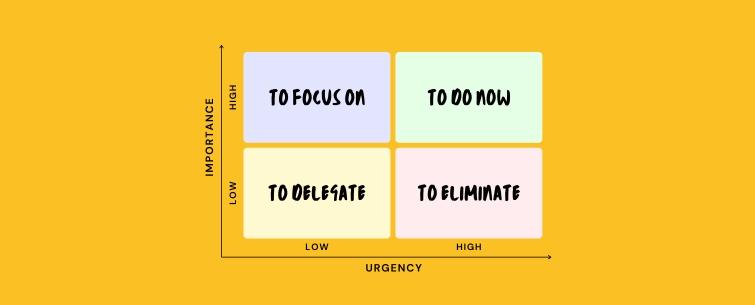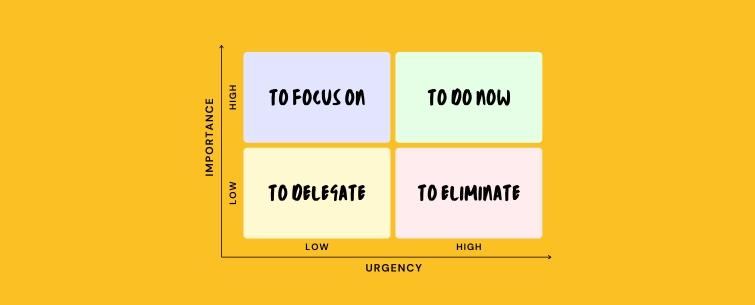These days it is almost impossible to recognize the difference between the things that are urgent and the ones that are important, especially at work.
Is something urgent always important? Is something important necessarily urgent?
The lack of distinction between urgency and importance creates a lot of problems, one of which is that people have to navigate a sea of tasks that demand their attention in equal measure. This is, by all means, unsustainable. Having no priorities, or everything being a priority, negatively impacts people’s wellbeing, but also their job performance. Focusing on all at the same time and in the same measure, is like focusing on nothing at all.
Enters: The Eisenhower Matrix.
The Eisenhower Matrix is a practical tool that allows people to make a clear distinction between urgency and importance. The matrix focuses on prioritizing tasks and managing time effectively, particularly focusing on Quadrant 2: tasks that are important but not urgent. This quadrant, emphasizing strategic planning, personal growth, and long-term goals, is where the magic of improved job performance and overall wellbeing happens.
Research shows the profound benefits of focusing on what is important (what really matters), rather than what is urgent (at least, on a regular basis). From reduced stress and burnout to increased productivity and job satisfaction, prioritizing tasks that align with our long-term goals and personal values help people excel professionally and nurture their mental and emotional health.
The Eisenhower Matrix
In 1954 president Dwight D. Eisenhower (34th President of the United States and a five-star general) said: “I have two kinds of problems, the urgent and the important. The urgent are not important, and the important are never urgent.”
And so, the Eisenhower Matrix was born. The Eisenhower Matrix is a way to organize tasks by urgency and importance. The purpose is to effectively prioritize what is most important, which leads to effectively investing time in the things that matter. This is conducive to preventing burnout, while also becoming more productive at work and improving your performance.
The Mere Urgency Effect
A 2018 study (The Mere Urgency Effect) found that when people are deciding what tasks to work on, they will consistently prioritize urgent tasks over important tasks – even when the urgent task offers much less of a reward.
This psychological phenomenon is called the Mere Urgency Effect and suggests that people will pick tasks with a short completion window because they provide more immediate payoff, instead of prioritizing important tasks with much larger reward that would take longer to complete.
Urgent: they are asks or activities that are time-sensitive and require immediate attention to avoid immediate consequences. Urgent activities typically support others in achieving their goals. They generally cause us to react. Often, we stop what we are currently doing to work on the urgent task instead.
Important: support strategic progress toward personal or professional long-term goals. Important tasks might not be time-sensitive or have a deadline. These key actions often require planning, organization and initiative.
The Quadrants
Quadrant 1: Crises (URGENT and IMPORTANT)
This quadrant is for tasks that are both urgent and important. They are immediate and unavoidable. These are the tasks that demand immediate attention and action. Examples include dealing with emergencies, critical deadlines, or last-minute preparations for scheduled important activities. Focusing too much on this quadrant can lead to stress and burnout because it often operates on a reactive mode rather than a proactive one.
Quadrant 2: Goals and Planning (NON-URGENT and IMPORTANT)
Tasks in this quadrant are not urgent but are important. They relate to long-term goals, strategic planning, and personal growth. This quadrant is where you want to spend most of your time because it focuses on activities that contribute to your future success and wellbeing, such as relationship building, long-term planning, and self-improvement. Working on this quadrant helps you to be proactive, setting you up for future success and reducing the crises of Quadrant 1.
Quadrant 3: Interruptions (URGENT and NOT IMPORTANT)
These tasks are urgent but not important. They are the distractions that demand your attention now but do not contribute to your long-term goals or success. They might include some emails, phone calls, or the demands of other people that can be postponed or delegated. The key to managing this quadrant is to differentiate between what appears to be urgent and what is genuinely important.
Quadrant 4: Distractions (NOT URGENT and NOT IMPORTANT)
This quadrant encompasses activities that are neither urgent nor important. They are the true distractions that can often be eliminated from your schedule. These tasks include mindless browsing on the internet, excessive social media use, or engaging in gossip. Spending too much time in this quadrant can lead to unproductiveness and may hinder your progress toward achieving your goals.
9 Strategies to Categorize Activities When Everything Seems to Be Urgent and Important
Pause and Assess: Before reacting to any task, take a moment to breathe and assess its true urgency and importance. This can prevent knee-jerk reactions to situations that may not be as critical as they seem. Benefit: This approach promotes mindfulness, reducing stress and increasing your ability to make informed decisions.
Prioritize Long-term Goals: Evaluate tasks based on how they align with your long-term objectives. If a task does not contribute to your goals, reconsider its priority. Benefit: This keeps your focus on the horizon, ensuring that your daily actions contribute to significant achievements over time.
Set Clear Deadlines: For tasks that seem important, assign clear deadlines. This helps in evaluating their urgency realistically, preventing procrastination and ensuring timely completion. Benefit: Clear deadlines improve time management and reduce anxiety by providing a structured approach to task completion.
Delegate When Possible: Identify tasks that can be handled by others. Delegating not only frees up your time for more critical tasks but also empowers your team by trusting them with responsibilities. Benefit: Delegation enhances team skills and efficiency while allowing you to focus on tasks that require your unique expertise.
Limit Interruptions: Actively manage your environment to reduce interruptions, such as setting specific times to check emails or turning off notifications during focus hours. Benefit: Limiting interruptions increases focus and productivity, ensuring quality work is done in less time.
Batch Similar Tasks: Grouping similar non-urgent and important tasks can be efficient. This approach minimizes the mental load of switching between different types of tasks. Benefit: Task batching enhances efficiency and mental clarity by reducing the cognitive load associated with task-switching.
Schedule Time for Reflection: Regularly set aside time to reflect on your priorities and the alignment of your tasks with your goals. This can be a weekly review where you assess what is working and what is not. Benefit: Reflection fosters continuous improvement and personal growth by ensuring your actions remain aligned with your desired outcomes.
Practice Saying No: Develop the skill to politely but firmly decline additional responsibilities that do not align with your priorities or contribute to your goals. Benefit: Saying no protects your time and energy for the tasks that truly matter, promoting a healthier work-life balance and preventing burnout.
Embrace Flexibility: Understand that priorities can shift and that being flexible in your planning allows you to adapt without stress. Adjusting your strategy to accommodate important, emerging tasks keeps you agile and responsive. Benefit: Flexibility in task management ensures you can pivot as needed, addressing the most critical tasks efficiently while maintaining balance.
Why Focusing on Quadrant 2 Helps with Your Overall Wellbeing and Mental Health
Reduces Stress: By spending more time on tasks that are important but not urgent, you reduce the last-minute rush and stress associated with urgent tasks.
Improves Focus: It allows for deeper work and focus on tasks that contribute to your long-term success and satisfaction.
Enhances Personal Growth: Quadrant 2 activities often involve self-improvement, learning, and relationship-building, which are key to personal development.
Prevents Burnout: By avoiding the constant firefighting mode of Quadrant 1, you maintain your energy and prevent burnout.
Increases Productivity: You achieve more in the long term by focusing on activities that directly contribute to your goals and objectives.
Improves Mental Health: Spending time on activities that fulfill you and move you towards your goals can improve your overall mental health and sense of well-being.
Enjoy Free Online Training For Human Resources Professionals
Hacking HR is the fastest-growing global community of people leaders and Human Resources professionals interested in all things at the intersection of people, organizations, innovation, transformation, the workplace and workforce, and more. We deliver value through hundreds of HR events, webinar and conferences a year, community engagement opportunities, learning programs, certificate programs, and more.
The Hacking HR Lab offers thousands of resources for HR practitioners.
Join our community platform, the Hacking HR LAB. Click here.



